Migration climaxes in May, with all of our summer visitors arriving back on territory, while migrants destined for more northerly continental breeding grounds are still very much on the move. There's also the welcome potential for scarce and rare stragglers from the south and east to be factored in. One species that encompasses all of these possibilities in a multitude of different guises is Western Yellow Wagtail, though the recently split and increasingly recorded Eastern Yellow Wagtail could add a further complication into the identification mix. Dominic Mitchell looks at the likely – and less likely – candidates.
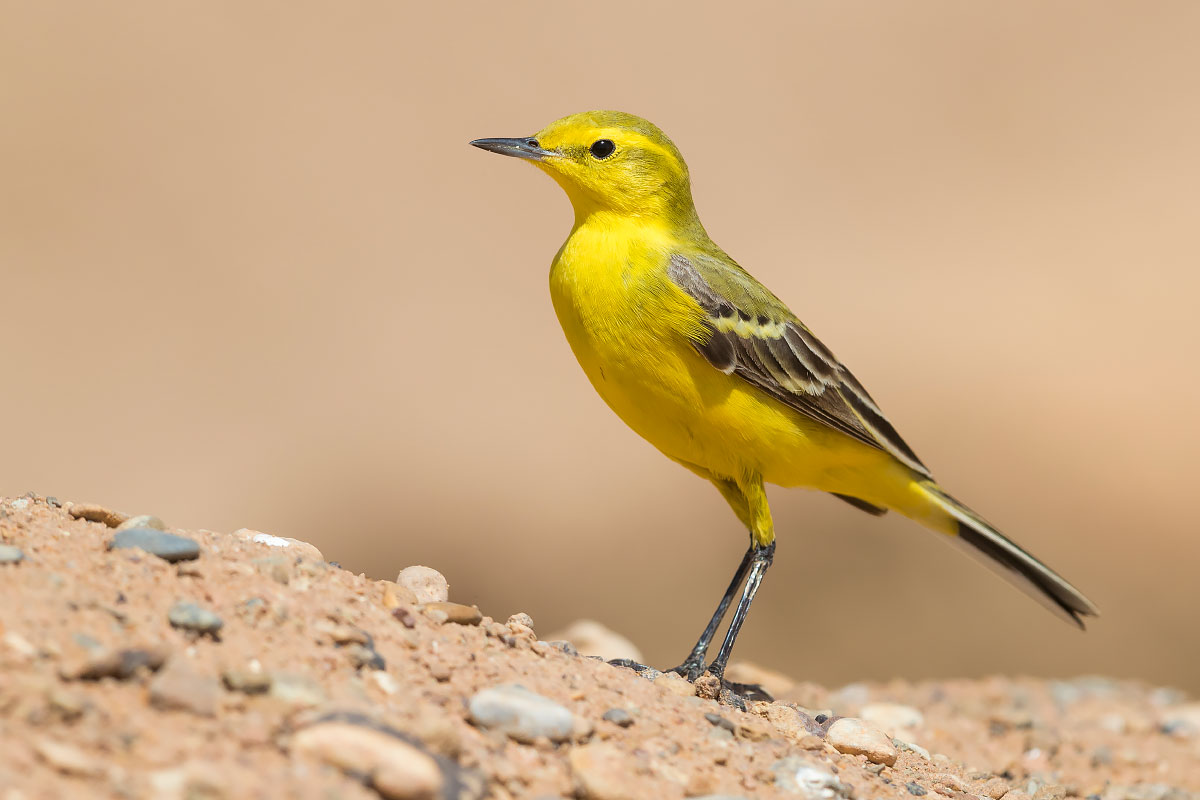
Western Yellow Wagtail (Draâ-Tafilalet, Morocco, 29 April 2018). Male Western Yellow Wagtail of the subspecies flavissima, breeding in Britain, Ireland and the near-Continent, is the most strikingly yellow of all 'Yellow Wagtails' breeding in Europe. The bright canary-yellow of the underparts extends all the way up onto the forehead and through the supercilium, and on this bird even tints the wing-bars, with greener tones restricted to the eyestripe, crown, nape, mantle and scapulars. Only one other subspecies, lutea from Central Asia, is brighter yellow, but vagrants of that form have only wandered as far west as Cyprus and Ukraine (Saverio Gatto / www.agami.nl).
The species that until recently was known simply as Yellow Wagtail has a remarkable breeding distribution, extending from north-west Africa and westernmost Europe across much of Eurasia to western and northern Alaska, and even into extreme north-west Canada. Unsurprisingly in such a vast range with so many habitats and differences in climate, various populations have evolved different plumages, vocal characteristics and habitat preferences.
Some of these distinctions have long been recognised at subspecies level, but more recent research into the genetics of the different forms has led to species-level division into Western and Eastern Yellow Wagtails, a view adopted by the IOC World Bird List and followed by the British Ornithologists' Union's Records Committee and the Irish Rare Birds Committee.
In contrast, however, Dutch taxonomic authorities divide western 'Yellow Wagtail' taxa into seven species, as follows: Yellow-crowned (monotypic flavissima), Blue-headed (nominate flava with subspecies beema, known as Sykes's), Grey-headed (monotypic thunbergi), White-throated (nominate cinereocapilla, with subspecies iberiae, Iberian, and pygmaea, Egyptian) and Black-headed (monotypic feldegg). While this alternative view has not been widely adopted, these wagtails are clearly some distance down the evolutionary road to becoming full species, even if interbreeding between some forms is more widespread than others.
Here we will consider the main European taxa and Eastern Yellow Wagtail, and focus chiefly on the all-important breeding plumages of males. Adults of both sexes of most Western Yellow Wagtail subspecies share rather similar greenish, greyish-green or greyish-brown upperparts, while males have well-saturated yellow underparts and females a more diluted, paler appearance. The key to visual identification is the head pattern of males, with females of some subspecies subtly distinctive but others indecipherable. Particularly in the case of potential vagrants, calls should also be listened to carefully – and ideally recorded for later analysis.
Western Yellow Wagtail
The default 'Yellow Wagtail' in Britain is the distinctive flavissima, which arrives back from wintering grounds in sub-Saharan Africa in April. It is a less frequent sight than previously, its numbers having plummeted by 72 per cent between 1970 and 2010, and its range has also contracted markedly. Nonetheless it can still be found from south-east England and East Anglia westwards through central England to eastern Wales, and northwards principally through eastern England to south-east Scotland. Birds occur more widely on passage. It is a scarce migrant in Ireland, occasionally also breeding there.
Adult male flavissima is unmistakable when seen well. At range it can appear almost yellow headed, though closer inspection should reveal a variably yellow-green tone to the crown, nape and ear coverts. No other European 'Yellow Wagtail' looks so yellow from head to toe, though the even brighter Central Asian form lutea, known as Yellow-headed Wagtail (and outside the scope of this article), has occurred as a vagrant west to Cyprus and Ukraine. Females are duller with a greyer head, white throat and paler yellow underparts, much like female Blue-headed though sometimes with a yellow-tinged supercilium.
Blue-headed Wagtail
Nominate flava is the most widespread form of Western Yellow Wagtail in continental Europe, breeding from France north to Germany and east to western Russia. Small numbers occur in Britain on migration, chiefly in the east, but it should be looked for anywhere. It is a vagrant to Ireland, and surprisingly has occurred on fewer occasions than southern overshoots such as Greater Short-toed Lark and Woodchat Shrike.
Breeding has taken place in Britain, principally in mixed flava × flavissima pairs, the offspring of which are known as Channel Wagtail, but pure pairs have also bred on occasion. There are three Irish breeding records.
Male Blue-headed Wagtail is distinctive with its blue-grey head, clean white supercilium and narrow white submoustachial stripe dividing the blue-grey 'cheek' – with small pale subocular patch – from the bright yellow underparts (though note that some first-summer males may show a white throat). Females are a much diluted version of the males, with a paler, subtler head colour, white supercilium, white throat and pale yellow underparts.
Hybrid male Channel Wagtails differ mostly in their lighter blue heads, a character which led to erroneous claims – and even acceptance – of Central Asian beema occurring in Britain. This taxon was removed from the British list in 2010.
Iberian Wagtail
As its name suggests, the form iberiae breeds in Spain and Portugal, and also in north-west Africa. In theory it might be expected as a spring overshoot, but in practice – and despite a number of strong claims over the years – there are just two accepted British records, from Filey, North Yorks, on 22 April 2015 and St Agnes, Scilly, on 21-22 April 2018. There are no Irish records.
Spring male Iberian Wagtail has an ashy-grey head, often slightly darker than in Blue-headed Wagtail, with darker grey cheeks and lores, a contrasting and well-defined white throat, and white supercilium which in some is absent in front of the eye. Females also resemble female Blue-headed, but some with less distinct supercilia tend more towards female Grey-headed, and may not be safely identifiable in a vagrancy context.
Ashy-headed Wagtail
The form cinereocapilla breeds in the north-west Balkans, Italy, southern France, Sicily and Sardinia, with a curiously disjunct population in south-west Morocco. In Britain there are six accepted records (and another four of cinereocapilla × iberiae), while Ireland has two breeding records, both from Co Down in 1956, and two of vagrants, in Co Antrim on 1 May 1985 and at two sites in Co Down on 9 and 10-11 May 1998.
Spring male Ashy-headed Wagtail closely resembles Iberian Wagtail, the chief distinction being that the supercilium is either just a small white stripe behind the eye or absent in many individuals. In this respect the head pattern is not unlike Grey-headed, except for the white throat (though note that first-summer male thunbergi can show this). Females are also very like iberiae, but with a less distinct supercilium that averages slightly narrower.
Grey-headed Wagtail
Replacing flava from Scandinavia eastwards into Siberia is thunbergi. It is most likely to occur in Britain during easterlies in May and early June, along North Sea coasts and especially in the Northern Isles. In average years about 15 are recorded in Scotland, but fall conditions can produce exceptional numbers: in May 1996 more than 260 were recorded, with peak counts of 52 at Loch of Spiggie and 25 on Fair Isle, both in Shetland. There are also at least five breeding records in Scotland.
Grey-headed Wagtail is scarcer in England, but there was an exceptional count of 25 at Happisburgh, Norfolk, on 15 May 1992. It is a major rarity in Ireland with just seven records.
Male Grey-headed Wagtail has a grey crown and nape and darker grey ear coverts, with no white markings whatsoever on the head. Some can appear almost black headed, creating confusion with Black-headed, so the exact tone and pattern need careful assessment. Females can closely resemble female flava, but many have shorter, less clear-cut supercilia and some may also have darker grey on the crown and cheeks.
Black-headed Wagtail
In south-east Europe, the Middle East and parts of Central Asia the default breeding taxon is feldegg. Unsurprisingly given its range, it is a rare vagrant to Britain, with 21 records to 2018, and an extreme vagrant to Ireland with just one record, from Lough Foyle, Co Derry, on 24 April 2007.
Typical males are striking with glossy jet-black heads contrasting with more greenish mantles, while some (often named 'melanogrisea' and occurring more commonly in the east of the range) show white on the throat sides and often also on the chin. Females are variable, but are often greyer above and whiter below than females of other subspecies, with darker heads.
Although hybrids occur between various Western Yellow Wagtail taxa, the three most distinctive are those involving Black-headed Wagtail and neighbouring subspecies. They have even been given subspecific names, though none is now considered valid: 'superciliaris' is black headed with a narrow white supercilium; 'xanthoprys' is similar but with a yellow supercilium; and 'dombrowskii' resembles flava but has blackish ear coverts and is slightly darker grey on the crown and nape.
The result of mixed breeding between feldegg and flava (perhaps also cinereocapilla and beema), and lutea in the case of 'xanthoprys', these distinctive hybrids may well be familiar to birders visiting the Middle East in spring.
Eastern Yellow Wagtail
This newly split species established itself on the British list on the basis of two old specimens, both supposedly involving 'simillima' (now subsumed within the subspecies tschutschensis) from Fair Isle, Shetland, on 9 October 1909 and 25 September 2012. Recent genetic analysis revealed that the former was of eastern origin but could not be assigned to subspecies, while the latter was in fact a Western Yellow Wagtail.
It was 101 years before the next record, a long-staying bird in Devon from 4-19 December 2010, and there have now been 10 accepted British records, all in late autumn and early winter. There is one Irish record, from Tory Island, Co Donegal, from 12-28 October 2013, this individual being confirmed by DNA as either plexa or tschutschensis.
However, 11 confirmed occurrences in 111 years are clearly not representative of Eastern Yellow Wagtail's true status: with improving knowledge of its field characters and call, and reports increasing each year, this species should prove to be less of an extreme rarity than the statistics indicate.
There is currently just a single spring record from Britain (on Scilly in April 2019), but the number of winter records in recent years suggests the species should be on our radar. There are four subspecies of Eastern Yellow Wagtail grouped into two clades, of which tschutschensis in the northern clade seems the most likely vagrant.
In males of this subspecies the forehead, crown and nape are grey and the supercilium is white, with ear coverts ranging from pale grey to almost black. Some are very like Blue-headed Wagtail but usually lack the pale subocular mark on the ear coverts. Females also resemble flava but often have darker grey ear coverts.
A more in-depth look at the various subspecies of Eastern Yellow Wagtail will appear in a forthcoming issue.
Voice
To my ears the typical call of flavissima Western Yellow Wagtail is a distinctive, high-pitched tseep, transcribed by some authors as pslie or psit, among other variations. Flava and thunbergi have identical calls, whereas iberiae, cinereocapilla and feldegg utter a harsher or buzzing note with a distinct 'r' sound, recalling Citrine Wagtail. However, these three taxa can also give flava-like calls, hence the importance of trying to record the voice of any potential vagrant.
Eastern Yellow Wagtail also has a sharp, harsh call even more like Citrine, as many who heard the Norfolk bird in winter 2019-20 will recollect – indeed such calls are, as in that instance, often the best way of detecting the presence of a rare 'Yellow Wagtail' in Britain and Ireland in the first place.
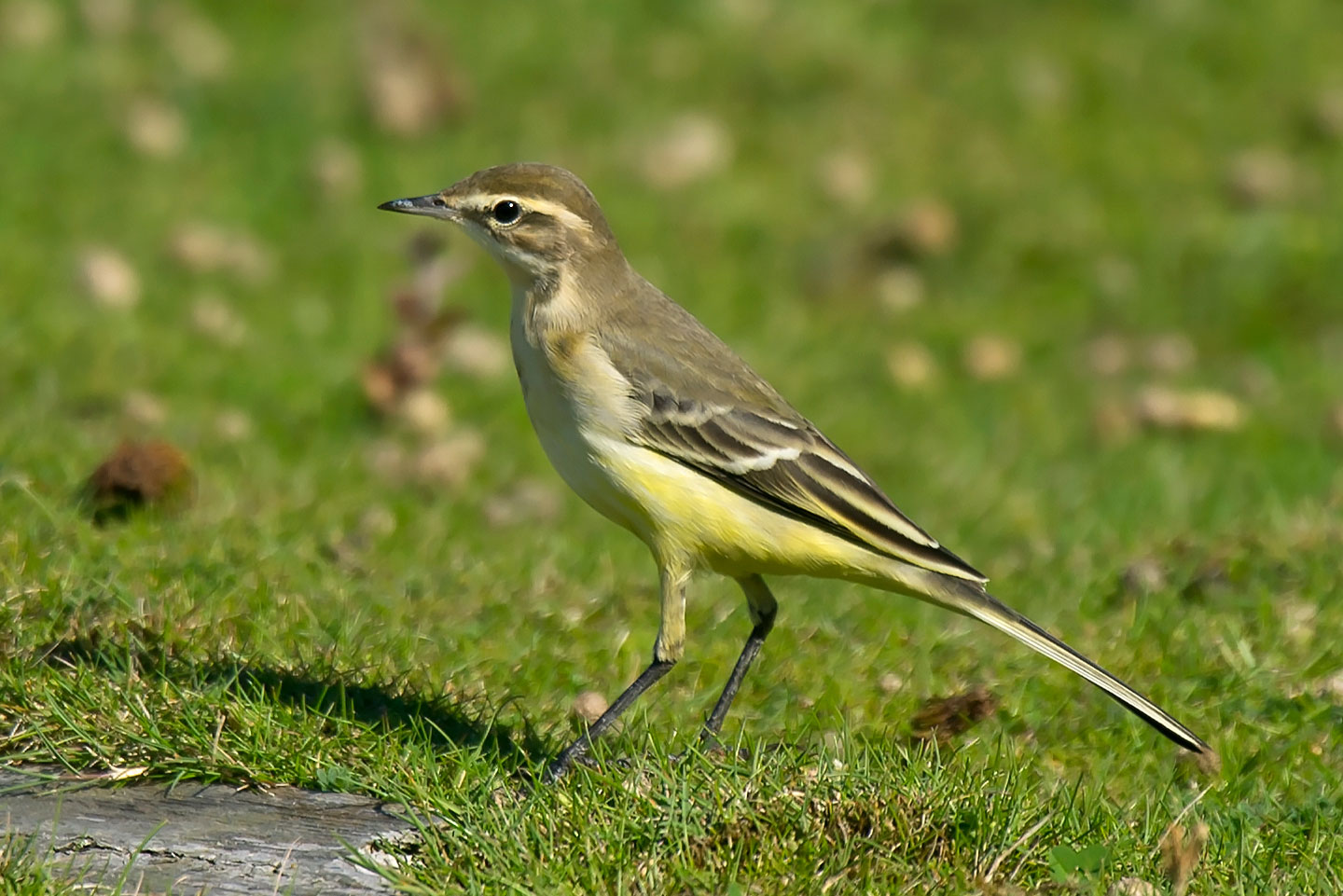
Western Yellow Wagtail (Seaforth NR, Lancashire, 25 August 2011). Females of many Western Yellow Wagtail taxa, especially those occurring in western Europe, are similar in appearance, and some are impossible to assign to subspecies other than by location. This late summer female in north-west England is clearly most likely to be flavissima on range alone, though flava is very similar in appearance; however, the yellow in the supercilium of this individual is also a good indicator of female flavissima (Steve Young).
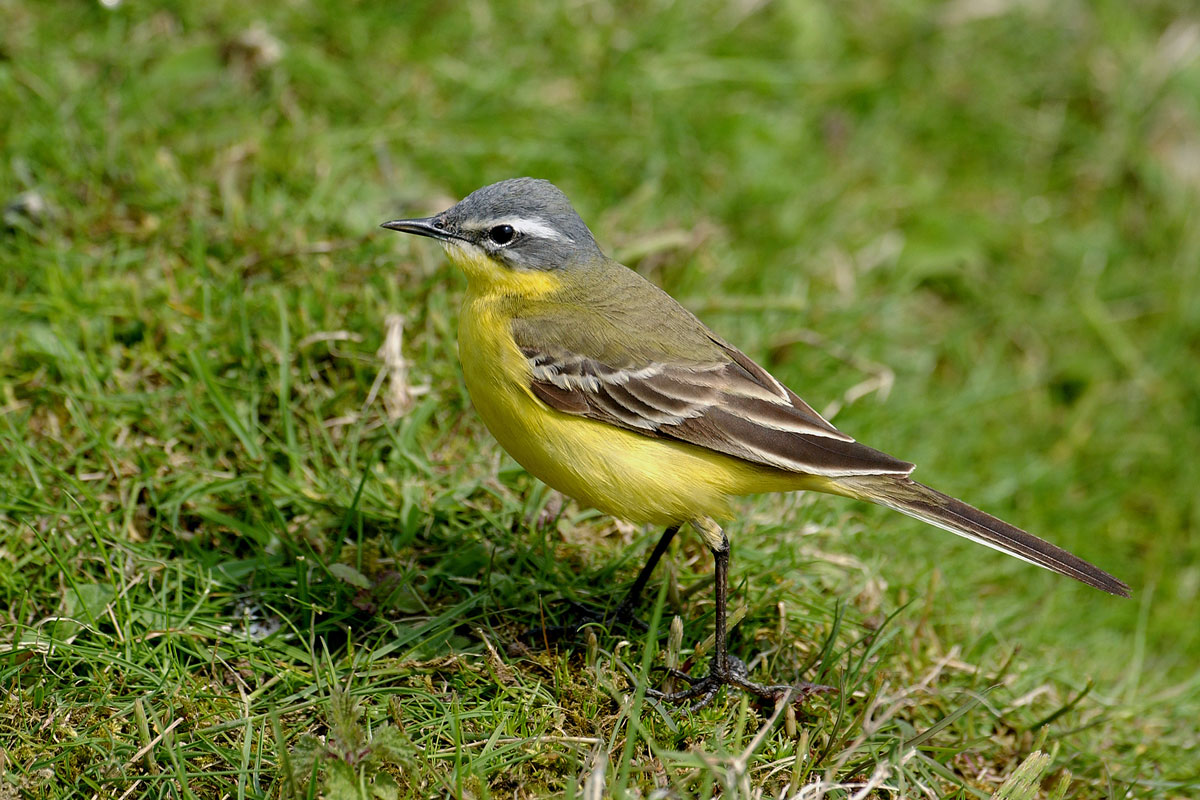
Blue-headed Wagtail (Seaforth NR, Lancashire, 1 May 2004). After flavissima, the most likely 'Yellow Wagtail' to reach Britain is nominate flava, Blue-headed, and birds like this colourful spring male stand out readily in a flock of migrant wagtails in spring. Note the blue-grey forehead, crown, nape and ear coverts, the white supercilium flaring behind the eye, and the small white subocular mark on the ear coverts. There is also a poorly developed narrow white submoustachial stripe dividing the blue-grey 'cheek' from the bright yellow throat (Steve Young).
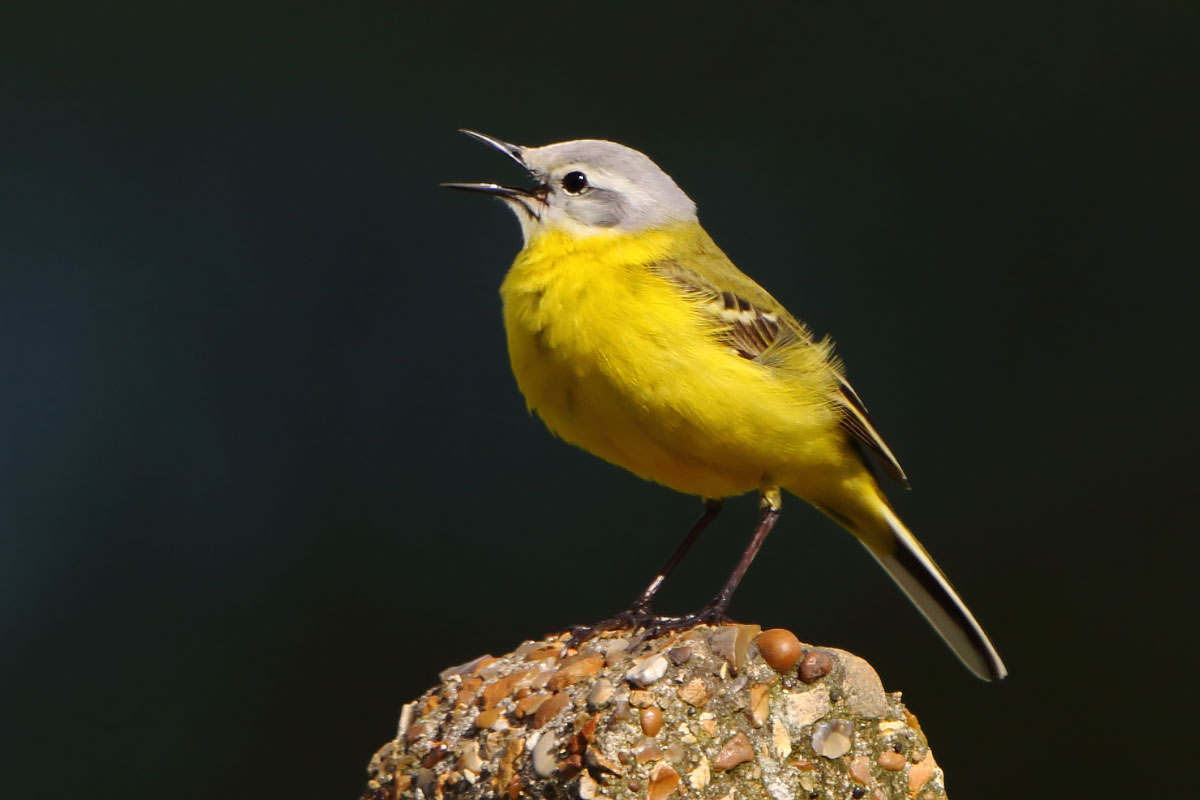
Channel Wagtail (Noneley, Shropshire, 25 April 2019). Mixed pairings of Yellow and Blue-headed Wagtails in Britain, Ireland and the Near Continent, including from an intergrade zone in northern France, produce offspring known colloquially as Channel Wagtail. Spring males generally resemble Blue-headed Wagtail, but are paler, almost powder-blue, on the forehead, crown, nape and ear coverts. They can also show more white in the supercilium, ear coverts and throat, and are thought to have been responsible for erroneous – and now rejected – British claims of Sykes's Wagtail from Central Asia (Jim Almond).
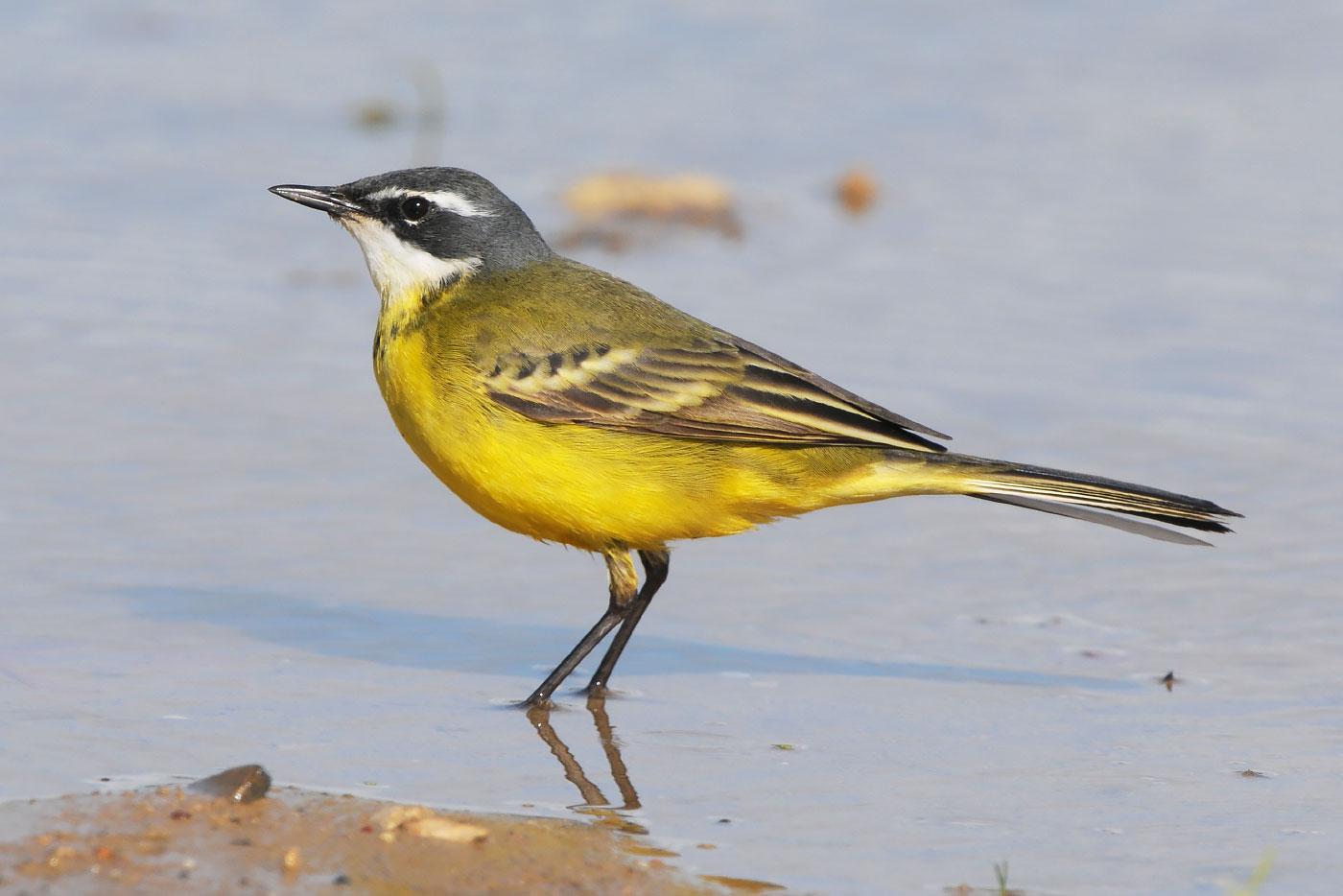
Iberian Wagtail (Faro, Portugal 28 March 2013). Iberian Wagtail shares many characters with Ashy-headed, with which it is known to intergrade. This spring male was photographed in southern Portugal, in the core breeding range of iberiae, and exhibits the classic ashy-grey head, dark grey cheeks and lores, a contrasting and well-defined white throat, and strong white supercilium, which when combined add up to a confident identification (Ray Tipper).
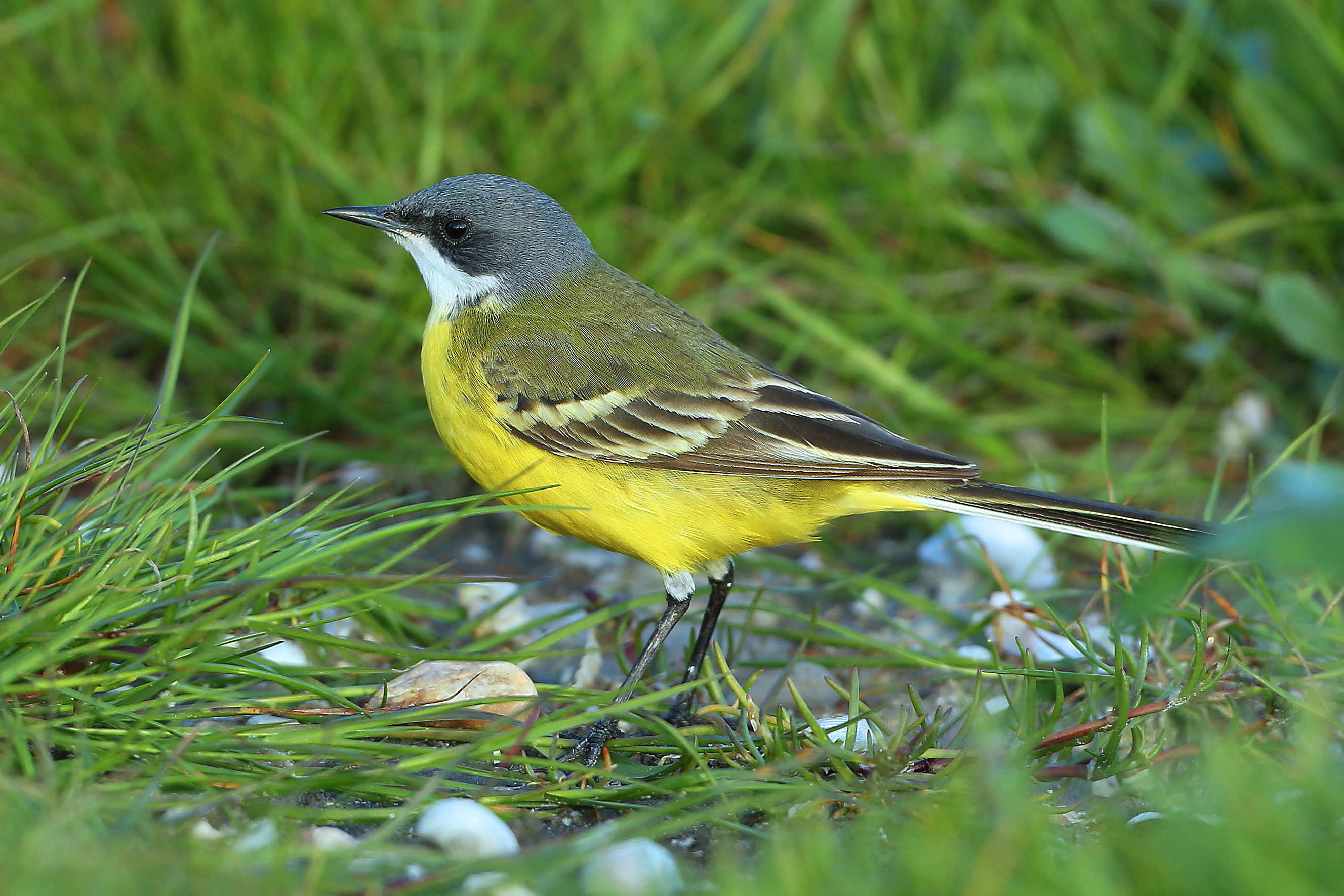
Ashy-headed Wagtail or intergrade (Var, France, 5 April 2013). This smart male wagtail exhibits the fundamental characters of Ashy-headed, with a grey forehead, crown and nape, darker grey ear coverts and lores, and a well-delineated white throat. There may just be a catch, however, as there is a hint of pale feathering in front of the eye – those male Ashy-headeds that do have a suggestion of a supercilium (many don't) should show it behind or above the eye rather than in front. This bird was also photographed on the Mediterranean coast of France, which is a known intergrade zone between iberiae and cinereocapilla (Aurélien Audevard).
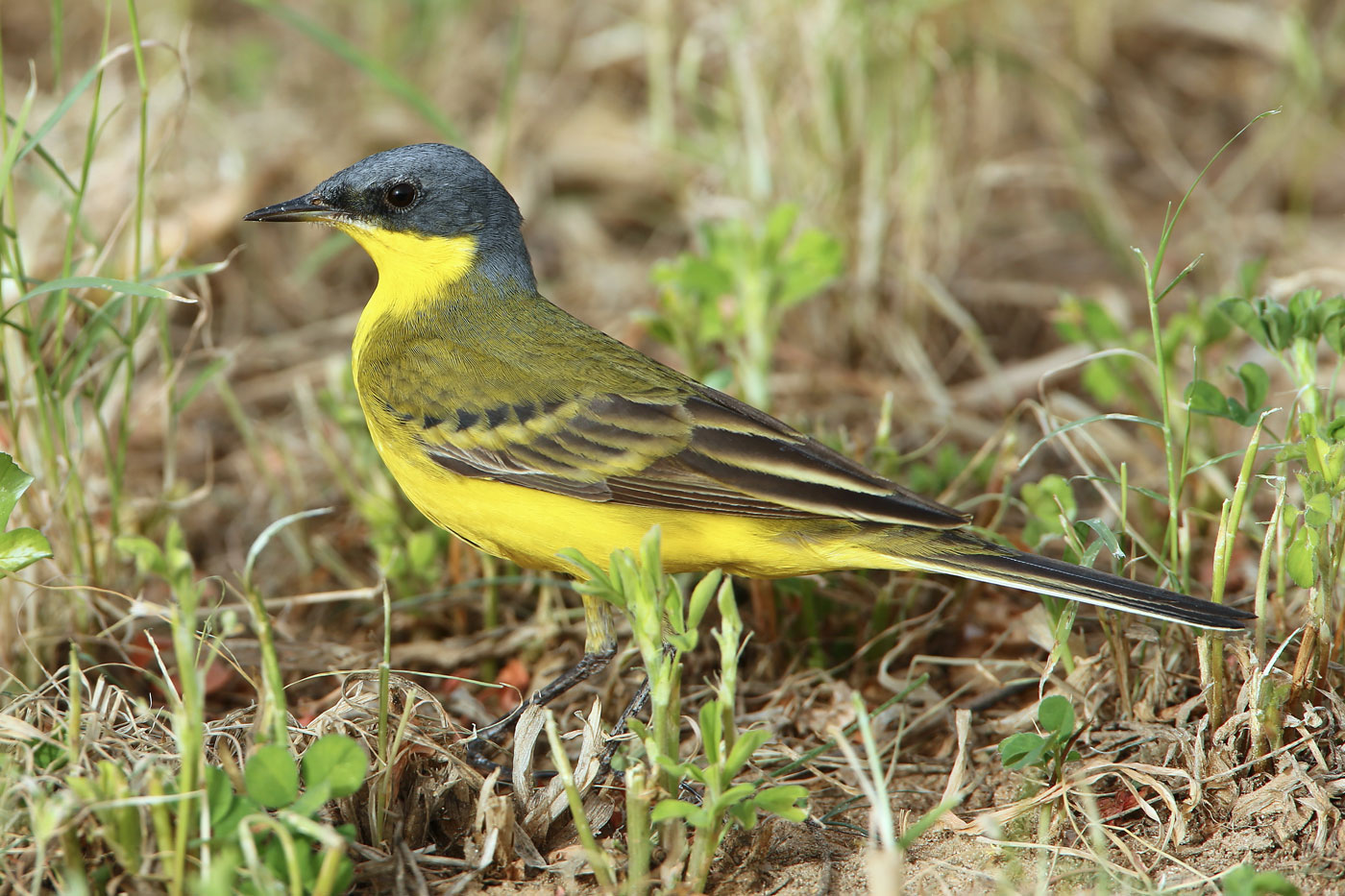
Grey-headed Wagtail (Al Abraq, Kuwait, 22 April 2015). Classic male thunbergi in spring has a grey head with slightly darker ear coverts and no white supercilium (though a few may have a faint line behind the eye); this bird has unmarked yellow underparts, but some show a 'necklace' of dark spots. In a few males the crown and nape can appear more or less black, inviting confusion with Black-headed Wagtail, and on such birds the exact colour needs careful assessment. Call is another clue – in Grey-headed it is similar to flavissima, while in feldegg it is more buzzing and Citrine-like (Aurélien Audevard).
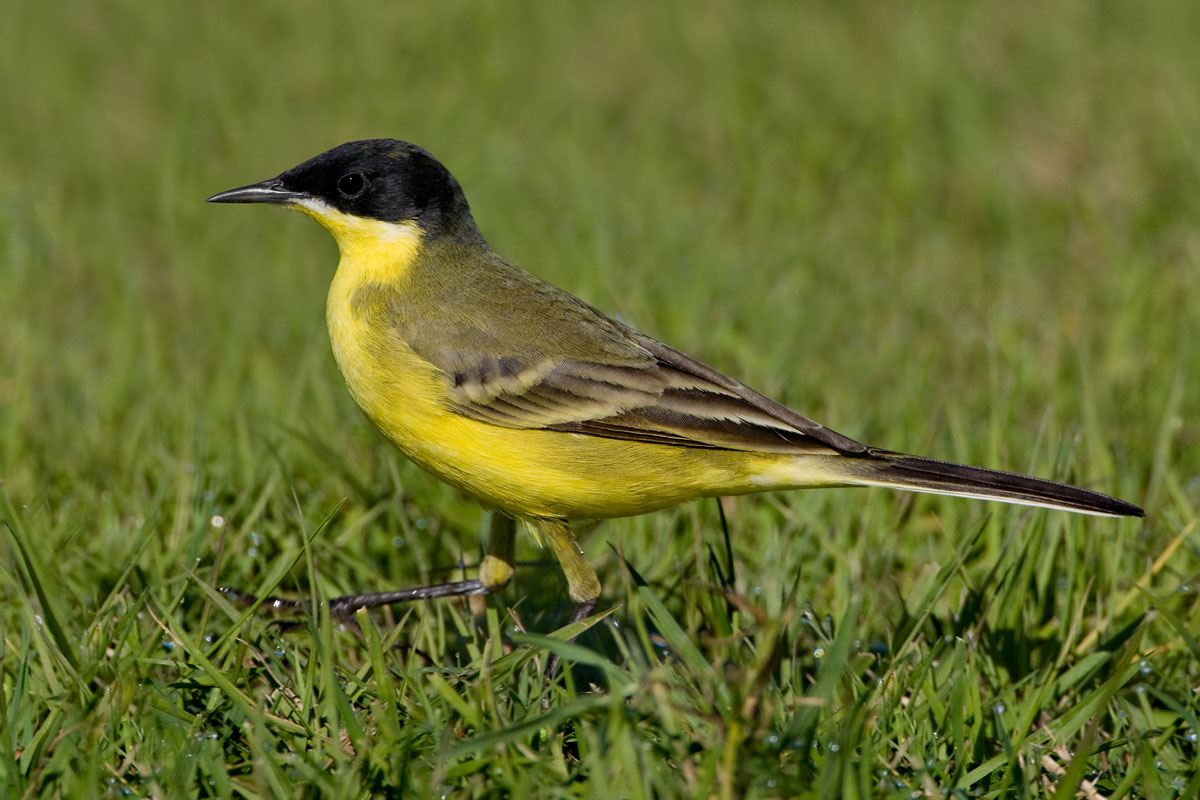
Black-headed Wagtail or intergrade (Tuscany, Italy, 3 April 2008). With its completely black head and bright yellow underparts, male feldegg is surely the most striking of all Western Yellow Wagtail forms. The lores, crown, nape and ear coverts should be unmarked glossy black; some, like this bird, show white on the throat sides and often also on the chin, and are named 'melanogrisea'. Males showing white or yellow supercilia or a greyer tone to the crown or nape are hybrids with other forms, and are often known by the invalid trinomials 'superciliaris', 'xanthoprys' and 'dombrowskii' respectively (Daniele Occhiato / www.agami.nl).
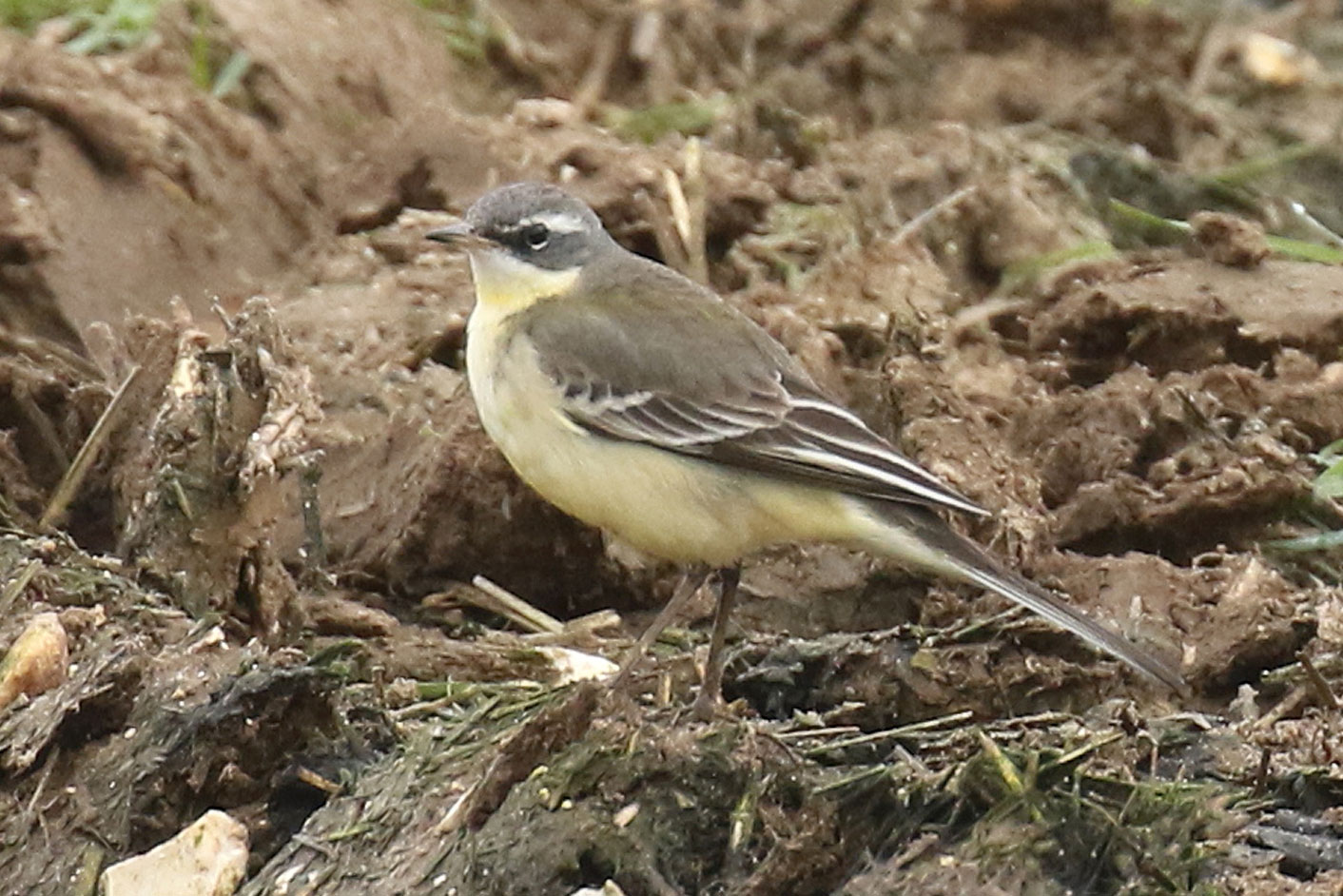
Eastern Yellow Wagtail (Sedgeford, Norfolk, 22 January 2020). Many of the first-winter Eastern Yellow Wagtails that have reached western Europe are distinctively grey and white, but this recent wintering male in Norfolk – considered by many to be of the subspecies tschutschensis – gives a much better impression of what a spring male should look like. Its appearance recalls a dull Blue-headed Wagtail, but the head is greyer and slightly darker, especially on the lores, and there is no pale subocular mark on the ear coverts (Dominic Mitchell).
Acknowledgements
Thanks to Roger Riddington for supplying a copy of the BBRC report for 2018.
- This article was originally published in the May 2020 issue of Birdwatch magazine.




